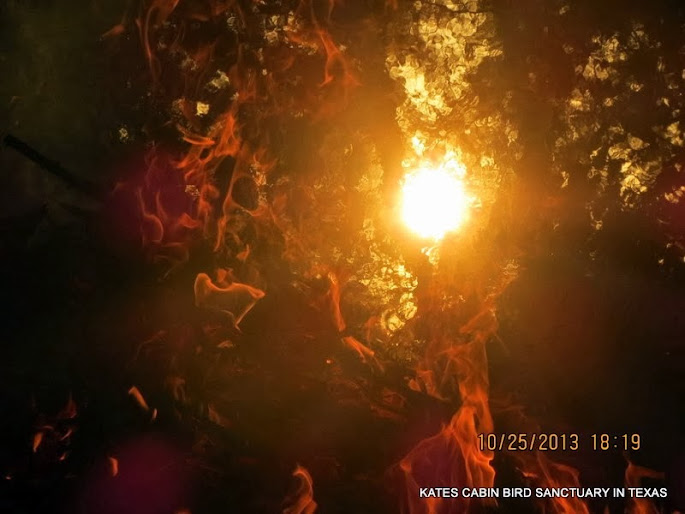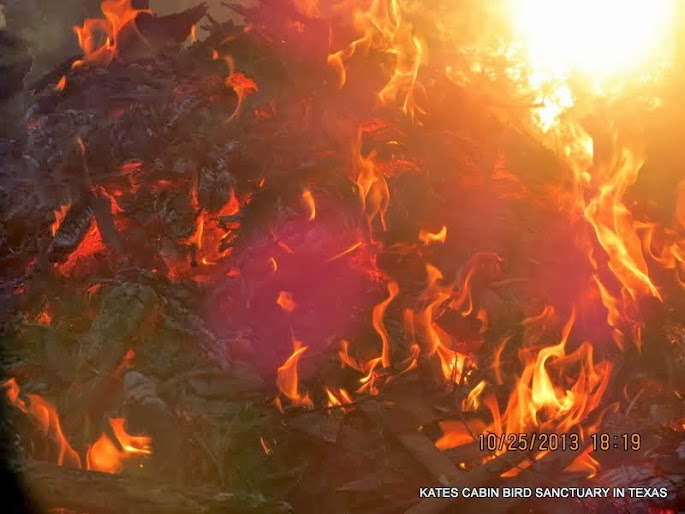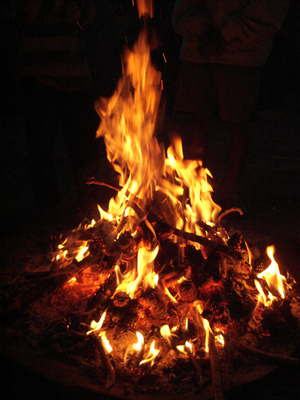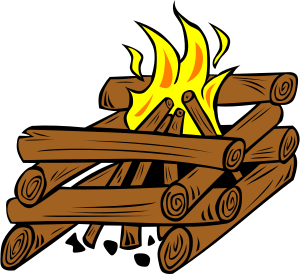
Hi Everybody!!
Today I made a campfire for my friend, +Lana in Canada. I decided to share it with all of us as we can all use some warmth and comfort. I did indeed catch that fire dancing in the sunset!! Below is your link to the fire photostudy in my G+ Albums. I have also shared some info from Wikipedia about campfires. I am asking everybody to sing and dance by the fire then just sit down and let your self get drawn into it. Lana, here is your warm, fuzzy Friday Night Special so You Know we are all with You-Never alone kiddo! Just look over your shoulder! Enjoy!







*******As You Know! The photostudy is now located in my G+Album Gallery. Below is the link to click on to go to slideshow:
link: https://plus.google.com/photos/117645114459863049265/albums/5938896646897941057

http://en.wikipedia.org/wiki/Campfire
Campfire
From Wikipedia, the free encyclopedia
A campfire is a fire lit at a campsite, to serve the following functions: light, warmth, abeacon, an insect and/or apex predator deterrent, to cook, and for a psychological sense ofsecurity. In established campgrounds they are usually in a fire ring for safety. Campfires are a popular feature of camping, particularly among organized campers such as Scouts orGuides.

Campfire history[edit]
First Campfire[edit]
A new analysis of burned antelope bones from caves in Swartkrans, South Africa, confirms that Australopithecus robustus andHomo erectus built campfires roughly 1.5 million years ago. [1] Nearby evidence within Wonderwerk Cave, at the edge of the Kalahari Desert, has been called the oldest controlled fire.[2] Microscopic analysis of plant ash and charred bone fragments suggests that materials in the cave were not heated above about 1,300 degrees Fahrenheit (700 degrees Celsius). This is consistent with preliminary findings that grasses, brushes and leaves were burned for these fires — such fuel would not have been capable of hotter flames. The data suggests humans were cooking their prey by campfire as far back as the first appearance of Homo erectus 1.9 million years ago. [3]
Campfire safety[edit]
Finding a site[edit]
Ideally, campfires should be made in a fire ring.[citation needed] If a fire ring is not available, a temporary fire site may be constructed. Bare rock or unvegetated ground is ideal for a fire site. Alternatively, turf may be cut away to form a bare area and carefully replaced after the fire has cooled to minimize damage. Another way is to cover the ground withsand, or other soil mostly free of flammable organic material, to a depth of a few inches. A ring of rocks is sometimes constructed around a fire. Fire rings, however, do not fully protect material on the ground from catching fire. Flying embers are still a threat, and the fire ring may become hot enough to ignite material in contact with it.
Safety measures[edit]
- Avoid building campfires under hanging branches or over steep slopes, and clear a ten-foot diameter circle around the fire of all flammable debris.[4]
- Have lots of water nearby and a shovel to smother an out-of-control fire with dirt.[4]
- Minimize the size of the fire to prevent problems from occurring.[4]
- Never leave a campfire unattended.[4]
- When extinguishing a campfire, use plenty of water, then stir the mixture and add more water. Afterward, check that there are no burning embers left whatsoever.[4] If water is unavailable, use dirt.[4] Take a green leaf and place it on your coals, if the leaf curls up the coals are still too hot.
- Never bury hot coals, they can continue to burn and cause root fires or wildfires.[4] Be aware of roots if digging a hole for your fire.
Types of fuel[edit]
There are, by conventional classification, three types of material involved in building a fire without manufactured fuels.
- Tinder lights easily and is used to start an enduring campfire. It is anything that can be lit with a match and is usually classified as being thinner than your little finger. A few decent natural tinders are birch bark, cedar bark, and fatwood, where available; followed by dead, dry pine needles or grass; a more comprehensive list is given in the article on tinder. Though not natural, steel wool makes excellent tinder and can be started with steel and flint, or a 9 volt battery without difficulty.
- Kindling is an arbitrary classification including anything bigger than tinder but smaller than fuelwood. In fact, there are gradations of kindling, from sticks thinner than a finger to those as thick as a wrist. A quantity of kindling sufficient to fill a hat may be enough, but more is better.
- Fuel can be different types of timber. Timber ranges from small logs two or three inches (76 mm) across to larger logs that can burn for hours. It is typically difficult to gather without a hatchet or other cutting tool. In heavily used campsites, fuelwood can be hard to find, so it may have to be brought from home or purchased at a nearby store.
In the United States, areas such as State Parks and National Parks which permit camping most often[citation needed] will allow the collection of wood lying on the ground with the exception of parks that have erosion problems (i.e. campgrounds that are neardunes). Cutting of living trees is almost always forbidden; Squaw wood (dead parts of standing trees) may also be prohibited.
Campfire construction styles
There are a variety of designs to choose from in building a campfire. A functional design is very important in the early stages of a fire. Most of them make no mention of fuelwood – in most designs, fuelwood is never placed on a fire until the kindling is burning strongly.
- The tipi fire-build takes some patience to construct. First, the tinder is piled up in a compact heap. The smaller kindling is arranged around it, like the poles of a tipi. For added strength, it may be possible to lash some of the sticks together. A tripod lashing is quite difficult to execute with small sticks, so a clove hitch should suffice. (Synthetic rope should be avoided, since it produces pollutants when it burns.) Then the larger kindling is arranged above the smaller kindling, taking care not to collapse the tipi. A separate tipi as a shell around the first one may work better. Tipi fires are excellent for producing heat to keep people warm.[citation needed] However, one downside to a Tipi fire is that when it burns, the logs become unstable and can fall over. This is especially concerning with a large fire.
- A lean-to fire-build starts with the same pile of tinder as the tipi fire-build. Then, a long, thick piece of kindling is driven into the ground at an angle, so that it overhangs the tinder pile. The smaller pieces of kindling are leaned against the big stick so that the tinder is enclosed between them.
- In an alternative method, a large piece of fuel wood or log can be placed on the ground next to the tinder pile. Then kindling is placed with one end propped up by the larger piece of fuel wood, and the other resting on the ground, so that the kindling is leaning over the tinder pile. This method is useful in very high winds, as the piece of fuel wood acts as a windbreak.
- A log cabin fire-build likewise begins with a tinder pile. The kindling is then stacked around it, as in the construction of a log cabin. The first two kindling sticks are laid parallel to each other, on opposite sides of the tinder pile. The second pair is laid on top of the first, at right angles to it, and also on opposite sides of the tinder. More kindling is added in the same manner. The smallest kindling is placed over the top of the assembly. Of all the fire-builds, the log cabin is the least vulnerable to premature collapse, but it is also inefficient, because it makes the worst use of convection to ignite progressively larger pieces of fuel. However, these qualities make the log cabin an ideal cooking fire as it burns for a long period of time and can support cookware.
- A variation on the log cabin starts with two pieces of fuelwood with a pile of tinder between them, and small kindling laid over the tops of the logs, above the tinder. The tinder is lit, and the kindling is allowed to catch fire. When it is burning briskly, it is broken and pushed down into the consumed tinder, and the larger kindling is placed over the top of the logs. When that is burning well, it is also pushed down. Eventually, a pile of kindling should be burning between two pieces of fuelwood. The logs will eventually catch fire from it.
- Another variation is called the funeral pyre method because it is used for building funeral pyres. Its main difference from the standard log cabin is that it starts with thin pieces and moves up to thick pieces. If built on a large scale, this type of fire-build collapses in a controlled manner without restricting the air flow.
- A cross-fire is built by positioning two pieces of wood with the tinder in between. Once the fire is burning well, additional pieces of wood are placed on top in layers that alternate directions. This type of fire creates coals suitable for cooking.
- A hybrid fire combines the elements of both the tipi and the log cabin creating an easily lit yet stable fire structure. The hybrid is made by first erecting a small tipi and then proceeding to construct a log cabin around it. This fire structure borrows benefits from both fire types: the tipi allows the fire to ignite easily and the log cabin sustains the fire for a long period of time.
- The traditional Finnish rakovalkea (literally "slit bonfire") is constructed by placing one long piece of fuelwood atop another, parallel, and bolstering them in place with four sturdy posts driven into the ground. (Traditionally, whole unsplit tree trunks are used for the fuelwood.) Kindling and tinder are placed between the logs in sufficient quantity (while avoiding the very ends) to raise the upper log and allow ventilation. The tinder is always lit at the center so the bolstering posts do not burn prematurely. The rakovalkea has two excellent features. First, it burns slowly but steadily when lit; it does not require arduous maintenance, but burns for a very long time. A well constructed rakovalkea of two thick logs of two meters in length can warm two lean-to shelters for a whole sleeping shift. The construction causes the logs themselves to protect the fire from the wind. Thus, exposure to smoke is unlikely for the sleepers; nevertheless someone should always watch in case of an emergency. Second, it can be easily scaled to larger sizes (for a feast) limited only by the length of available tree trunks.
- Schwedenfackel, or Schwedenfeuer (Schwedenfeuer, German Wikipedia). Roughly translated, it means "Swedish fire torch", also known by other names, including Swedish (log) candle, and Swedish log stove. It is unique because it uses only one piece of fairly decent sized fuelwood as its fuel. The log is either cut (usually only partially, but other variants do include totally splitting) and then set upright (ideally, the log needs to be cut evenly and on a level surface for stability). Tinder and kindling are added to the preformed chamber, from the initial cuts. Eventually, the fire is self-feeding. The flat, circular top provides a surface to place a kettle, or pan for cooking, boiling liquids, etc. The elevated position of the fire can serve as a better beacon than the typical ground based campfire in some instances.[5][6]
- A keyhole fire is made in a keyhole-shaped fire ring, and is used in cooking. The large round area is used to build a fire in order to create coals. As coals develop, they are scraped into the rectangular area used for cooking.
- A "top lighter" fire is built similar to a log cabin or pyre, but instead of the tinder and kindling being placed inside the cabin, it is placed in a tipi on top. The small tipi is lighted on top, and the coals eventually fall down into the log cabin. These fires are often built by youth outdoor movements for "council fires" or ceremonial fires. They burn very predictably, and with some practice a builder can estimate how long they will last. They also do not throw off a lot of heat, which isn't needed for a ceremonial fire. The fire burns from the top down, with the layer of hot coals and burning stubs igniting the next layer down.
- Another variation to the top lighter, log cabin, or pyre is known by several names, most notably the pyramid, self-feeding, and upside-down [method]. The reasoning for this method are twofold. First, the layers of fuelwood take in the heat from the initial tinder/kindling therefore it is not lost to the surrounding ground. In effect, the fire is "off the ground", and burns its way down through its course. And secondly, this fire type requires minimal labor, thereby making it ideal as a fire of choice before bedding down for the evening without having to get up periodically to add fuelwood and/or stoke the fire to keep it going. Start by adding the largest fuelwood in a parallel "layer", then continue to add increasingly smaller and smaller fuelwood layers perpendicularly to the last layer. Once enough wood is piled, there should be a decent "platform" to make the tipi [tinder/kindling] to initiate the fire.
- A "Star Fire", or "Indian Fire", is the fire design often depicted as the campfire of the old West. Imagine five or six logs laid out like the spokes of a wheel (star shaped). A fire is started at the "hub" and each log is pushed towards the center as the ends are consumed. First one will need to build a small ditch, about 5 inches across, with a depth of about an inch. Next set up 5 or 6 fuelwoods (about the size of your forearms in a star around the ditch with a little bit of the end sticking in over it. You will then line the inside of the ditch and a few inches inside the pieces of fuelwood with kindling. Make sure to have much more kindling set aside for later use. Set up a tinder nest on top of the kindling in the ditch. You can then surround the tinder with more kindling. The more the better, of course without disrupting the flow of oxygen, and allowing easy access to the tinder to light. Proceed to light the tinder with a match or lighter; Or lighting you coal using one the many different primitive fire starting techniques and transferring it to the tinder nest. Blow gently yet firmly until a fire is lit. Add kindling as needed until the ends of the fuel ignites. As the fuel is slowly burned you will proceed to push in the logs by the ends to keep the fire burning. When the fuel runs short you can simply add more fuelwood. This fire is ideal for calm conditions. It is another fire that can be kept burning all night long with little maintenance. The fire can be controlled easily, and is a great cooking fire because it is so predictable. Especially if you will be cooking using bushcraft and other primitive methods such as a T-bar hold for roasting and hanging pots for boiling.
Lighting the fire[edit]
Once the fire is built, the next step is to light the tinder, using either an ignition device such as a match or a lighter. A reasonably skillful fire-builder using reasonably good material will only need one match. The tinder will burn brightly, but be reduced to glowing embers within half a minute. If the kindling does not catch fire, the fire-builder must gather more tinder, determine what went wrong and try to fix it.
One of five problems can prevent a fire from lighting properly: wet wood, wet weather, too little tinder, too much wind, or a lack of oxygen. Rain will, of course, douse a fire, but a combination of wind and fog also has a stifling effect. Metal fire rings generally do a good job of keeping out wind, but some of them are so high as to impede the circulation of oxygen in a small fire. To make matters worse, these tall fire rings also make it very difficult to blow on the fire properly.
Steady, forceful blowing may be in order for a small fire in an enclosed space that has mysteriously slowed down, but blowing may extinguish a fire if it is done abruptly or when it is not needed. Most large fires easily create their own circulation, even in unfavorable conditions, but the variant log-cabin fire-build suffers from a chronic lack of air so long as the initial structure is maintained.
Once the large kindling is burning, all of the kindling should be put on the fire, save for one piece at least a foot long. This piece is useful later to push pieces of fuelwood where they are needed. Once all of the kindling is burning, the fuelwood should be placed on top of it (unless, as in the rakovalkea fire-build, it is already there). For best results, two or more pieces of fuelwood should be leaned against each other, as in the tipi fire-build.
Campfire activities[edit]
Campfires have been used for cooking since time immemorial. Possibly the simplest method of cooking over a campfire and one of the most common is to roast food on long skewers that can be held above the flames. This is a popular technique for cooking hot dogs or toasting marshmallows for making s'mores. Another technique is to use pie irons — small iron molds with long handles, into which can be placed slices of bread with some form of filling — which are placed over hot coals to cook. More elaborate grills, cast iron pots and fire irons can be used on the campfire to cook most foods. However, portable stoves are often used instead of campfires for cooking.
- For more information, see Campfire cooking.
Other practical, though not commonly needed, applications for campfires include drying wet clothing, alleviating hypothermia, and distress signaling.
Most campfires, though, are lit exclusively for recreation, often as a venue for conversation, storytelling; or song. Another traditional campfire activity involves impaling marshmallows on sticks or uncoiled wire coat hangers, and roasting them over the fire. Roasted marshmallows may also be used for s'mores.

...this is brendasue signing off from Rainbow Creek. See You next time! I'll keep the home fires burning! Sending Warmth and Love to All

Please have compassionate thoughts for our friends in Japan facing several events of Nature at the same time in the same place.
For an update see this link: http://sincedutch.wordpress.com/2013/10/25/10252013-7-2m-earthquake-directly-underneath-typhoon-lekima-tropical-storm-francisco/
O+O









No comments:
Post a Comment
Hi Everybody! Please say hello and follow so I know you are here! Due to the inconsideration of people trying to put commercials on my blog comment area, I have restricted use of anonymous posts. Sorry that some hurt all.
My public email is katescabin@gmail.com No spammers or trolls